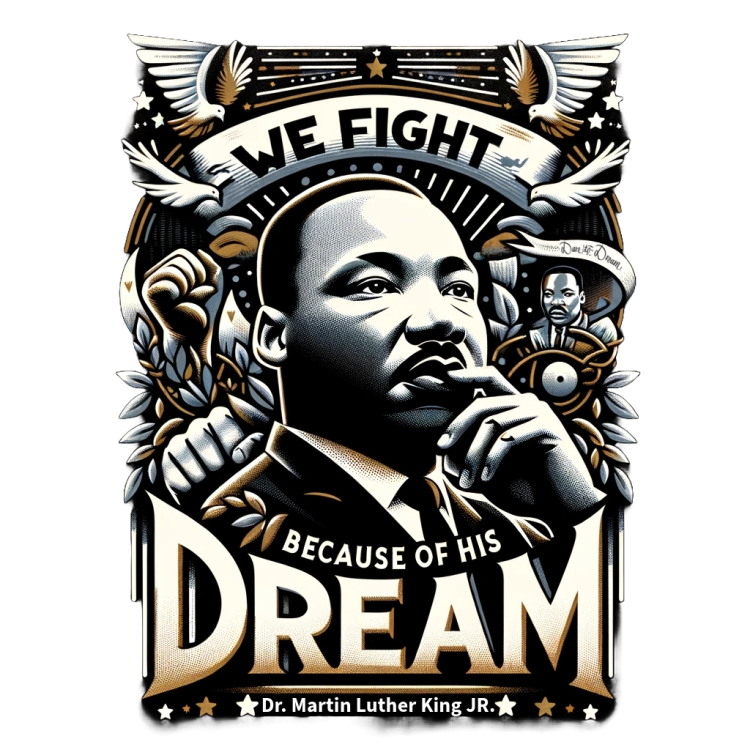In the heart of every struggle for equality and justice, there echoes the powerful legacy of Dr. Martin Luther King Jr. (1929-1968)
Dr. King, an unwavering agent of change, pioneered a path for equality, an emblem of hope and a symbol of relentless struggle, used nonviolent resistance to confront the gnarled roots of racism and inequality. He didn’t just dream; he mobilized a nation towards that dream. His methods, deeply rooted in love, empathy, and understanding, broke barriers and built bridges.
Fast forward to today, where the fight for racial equality and justice still rages. Contemporary Black leaders and figures, such as Alicia Garza, Opal Tometi, and Patrisse Cullors, founders of the Black Lives Matter (BLM) movement, political activist, Stacey Abrams, and cultural theorists Ibram X. Kendi, and Brittney Cooper are the torchbearers of Dr. King’s legacy. Their activism, though contextually different, is fueled by the same desire for systemic change. They too use nonviolent resistance, yet their methods have evolved to include digital platforms, enabling a global reach and immediate impact.
The similarities between Dr. King’s methods and those of BLM are striking. For instance, Dr. King’s advocacy for nonviolent protest was a defining feature of the Civil Rights Movement, and this approach is mirrored in BLM’s strategy. The peaceful protests following the tragic death of George Floyd in 2020, organized and carried out under the BLM banner, echo the peaceful demonstrations led by Dr. King. Additionally, just as Dr. King was known for his ability to mobilize communities through church gatherings and eloquent public speeches, BLM too has shown a remarkable capacity for community mobilization. However, BLM extends this outreach beyond physical gatherings, leveraging digital platforms to organize protests, disseminate information, and create a sense of shared purpose and community through social media [1].
Stacey Abrams has become a prominent figure in American politics, particularly in the realm of voting rights. Her work, especially with Fair Fight Action, an organization she founded to address voter suppression, aligns closely with Dr. King’s legacy of advocating for civil rights, especially the right to vote [2]. Like Dr. King, Abrams utilizes grassroots organizing, legal challenges, and public advocacy to combat systemic barriers to voting. Her efforts, particularly in the state of Georgia, have been credited with increasing voter registration and participation among underrepresented communities [3], echoing Dr. King’s emphasis on political participation to achieve social justice.
Ibram X. Kendi is a leading scholar in the study of racism and has contributed significantly to contemporary understandings of racism and anti-racism through his writings, including his book “How to Be an Antiracist”[4]. Kendi’s work, focusing on systemic racism and the ways to dismantle it, can be seen as a continuation of Dr. King’s struggle against the institutional and societal structures that perpetuate racial inequality. While Dr. King’s activism was more visibly centered around direct action and public speeches, Kendi’s approach is more academic, yet both aim to educate and provoke thought around issues of race and justice.
Brittney Cooper, as a cultural theorist, writer, and professor, brings a feminist perspective to the conversation about race and justice, much in the way Dr. King’s activism was informed by a broader vision of social justice that included but was not limited to race. Cooper’s work, especially in her book “Eloquent Rage: A Black Feminist Discovers Her Superpower”[5], explores the intersections of race, gender, and politics. Her approach to activism, like Dr. King’s, involves using her voice and platform to challenge societal norms and advocate for marginalized communities, though her methods are more focused on feminist theory and academic discourse.
Each of these modern figures, while inspired by Dr. King, brings their own expertise and perspective to the fight for racial justice and equality. Their methods, ranging from political activism and grassroots organizing to scholarly research and feminist theory, represent an expansion and diversification of the approaches to civil rights activism. They demonstrate how Dr. King’s legacy continues to influence and inspire new generations of activists, who adapt his message to the ever-evolving social and political landscape.
These leaders, along with countless others, are not mere reflections of Dr. King but are extensions of his dream, adapting his vision to the needs and challenges of our time. They are the embodiment of what it means to not only see change but to be the harbingers of it.
This brings us to a critical reflection. In the face of ongoing injustice, what is our role? Dr. King’s life begs us to question the depth of our activism. Are we passive observers or active participants in the march toward equality? And in this questioning, we must ask ourselves, for whom do we fight? Is it for ourselves, our community, or for a future where justice is not just a dream but a reality? Moreover, do we recognize change when it unfolds before us? Change is often a slow, painful process, not always marked by monumental victories. Sometimes, it’s in the subtle shifts in societal attitudes, in small acts of courage by ordinary people, or in the persistent chipping away at long-standing barriers.
Finally, Dr. King challenges us to confront our own dreams. Do we dare to dream in a world that often seems insistent on crushing those dreams? The audacity to dream is perhaps the most significant legacy left by Dr. King. We must continue to question, challenge, and dream. And in doing so, we honor not just Dr. King, but all those who have dared to dream of equality and justice.
Happy Dreaming,
Christina Alston, PhD
Director, Colorado Diversity Initiative
Faculty Affiliate, School of Education
Incoming Chair, Commission DEI, American Society Engineering Education




